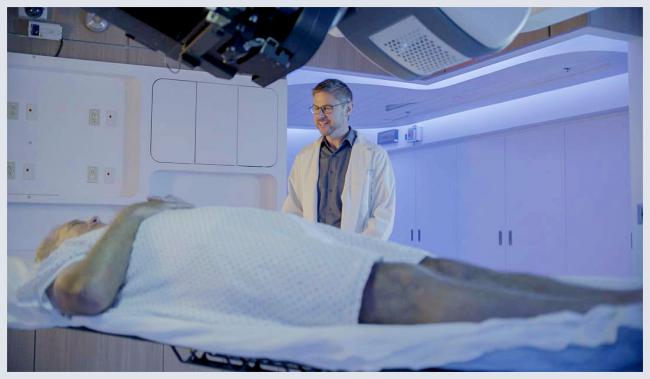Traditional prostate cancer treatment involving surgery or radiation carries the risk of serious toxicity and side effects. The potential long-term impact of these side effects on quality of life forces men to make a difficult choice during a stressful time.
Proton radiation for prostate cancer treatment offers an innovative method of radiation treatment intended to lower the risk of prostate cancer treatments and side effects.
For treating cancer of the prostate, proton therapy offers multiple benefits:
- Excellent control of tumors, thanks to more precise targeting of radiation
- Lower risk of damage to healthy tissue surrounding the prostate cancer
- Better quality of life for patients undergoing prostate proton therapy treatments
Lowering the risks for treatment
An alternative to traditional prostate cancer treatment.
Proton radiation for prostate cancer delivers precise doses of radiation with a lower risk of side effects. The difference is in the protons themselves. Since physicians have greater control over the distribution of the proton radiation dose, higher, more effective doses can be used.
And since proton therapy lacks an “exit dose,” and has a lower entrance dose than conventional X-rays, damage to critical tissue near the prostate is reduced, potentially lessening the likelihood of prostate cancer side effects like impotence, incontinence and gastrointestinal disorders. The figure to the right demonstrates the difference in radiation dose distribution between a conventional IMRT plan on the bottom and a proton plan on the top.
As apparent, much less of the pelvis is exposed to radiation with the proton plan, likely leading to a lower risk of secondary cancers in prostate cancer survivors. Also apparent is a lower dose of radiation to the rectum, which may lead to a lower risk of rectal injury with proton therapy.

What are the results of using proton therapy in patients?
For patients facing prostate cancer, treatments and side effects present unique challenges in choosing a therapy. Proton radiation for prostate cancer treats the disease with successful outcomes and a low risk of side effects.
For thousands with cancer of the prostate, proton therapy has offered an effective, virtually painless option for prostate cancer treatment. Since the University of Florida Health Proton Therapy Institute opened in 2006, thousands have undergone proton therapy for prostate cancer, and prostate cancer patients at the UF Health Proton Therapy Institute enjoy a close-knit community of fellow patients, caregivers and spouses. Today, prostate cancer is one of many types of cancer treated at the Institute.
1Henderson RH, Bryant CM, Nichols RC, Mendenhall WM, Hoppe BS, Su Z, Morris CG, Mendenhall NP. Five- and seven-year outcomes for image-guided moderately accelerated hypofractionated proton therapy for prostate cancer. Acta Oncol. 2022 Apr;61(4):468-477. doi: 10.1080/0284186X.2021.2016948. Epub 2021 Dec 30. PMID: 34965846. https://www.tandfonline.com/doi/full/10.1080/0284186X.2021.2016948
2Mendenhall NP, Rausch Osian SM, Bryant CM, Hoppe BS, Morris CG. What men want: Results from a national survey on decision making for prostate cancer treatment and research participation. Clin Transl Sci. 2021 Nov;14(6):2314-2326. doi: 10.1111/cts.13090. Epub 2021 Aug 11. PMID: 34379363; PMCID: PMC8604236. https://ascpt.onlinelibrary.wiley.com/doi/10.1111/cts.13090
3Bryant CM, Henderson RH, Nichols RC, Mendenhall WM, Hoppe BS, Vargas CE, Daniels TB, Choo CR, Parikh RR, Giap H, Slater JD, Vapiwala N, Barrett W, Nanda A, Mishra MV, Choi S, Liao JJ, Mendenhall NP; Genitourinary Subcommittee of the Particle Therapy Co-Operative Group. Consensus Statement on Proton Therapy for Prostate Cancer. Int J Part Ther. 2021 Apr 12;8(2):1-16. doi: 10.14338/IJPT-20-00031.1. PMID: 34722807; PMCID: PMC8489490. https://www.ncbi.nlm.nih.gov/pmc/articles/PMC8489490/
4Bryant CM, Hoppe BS. Promising long-term results with proton therapy for localized prostate cancer. Nat Rev Urol. 2021 Mar;18(3):137-138. doi: 10.1038/s41585-021-00429-5. PMID: 33505007. https://www.nature.com/articles/s41585-021-00429-5
5Xiang M, Chang DT, Pollom EL. Second cancer risk after primary cancer treatment with three-dimensional conformal, intensity-modulated, or proton beam radiation therapy. Cancer. 2020;126(15):3560-3568. doi:10.1002/cncr.32938. https://acsjournals.onlinelibrary.wiley.com/doi/10.1002/cncr.32938
6Holtzman AL, Bryant CM, Mendenhall NP, Mendenhall WM, Nichols RC, Henderson RH, Figura N, Morris CG, Williams CR, Li Z, Hoppe BS. Patient-Reported Sexual Survivorship Following High-Dose Image-Guided Proton Therapy for Prostate Cancer. Radiother Oncol. 2019 May;134:204-210. doi: 10.1016/j.radonc.2019.01.029. Epub 2019 Feb 27. PMID: 31005217. https://www.thegreenjournal.com/article/S0167-8140(19)30056-8/fulltext
7Bryant C, Smith TL, Henderson RH, Hoppe BS, Mendenhall WM, Nichols RC, Morris CG, Williams CR, Su Z, Li Z, Lee D, Mendenhall NP. Five-Year Biochemical Results, Toxicity, and Patient-Reported Quality of Life After Delivery of Dose-Escalated Image Guided Proton Therapy for Prostate Cancer. Int J Radiat Oncol Biol Phys. 2016 May 1;95(1):422-434. doi: 10.1016/j.ijrobp.2016.02.038. Epub 2016 Feb 16. PMID: 27084658. https://www.redjournal.org/article/S0360-3016(16)00158-9/fulltext
8Mendenhall NP, Hoppe BS, Nichols RC, Mendenhall WM, Morris CG, Li Z, Su Z, Williams CR, Costa J, Henderson RH. Five-year outcomes from 3 prospective trials of image-guided proton therapy for prostate cancer. Int J Radiat Oncol Biol Phys. 2014 Mar 1;88(3):596-602. doi: 10.1016/j.ijrobp.2013.11.007. PMID: 24521677. https://www.tandfonline.com/doi/full/10.1080/0284186X.2017.1287946
9Mendenhall WM, Henderson RH, Hoppe BS, Nichols RC, Mendenhall NP. Androgen deprivation therapy and definitive radiotherapy for prostate cancer. Am J Clin Oncol. 2013;36(5):530-534. doi:10.1097/COC.0b013e31821dee4e. https://journals.lww.com/amjclinicaloncology/Abstract/2013/10000/Androgen_Deprivation_Therapy_and_Definitive.20.aspx
10Hoppe BS, Nichols RC, Henderson RH, Morris CG, Williams CR, Costa J, Marcus RB Jr, Mendenhall WM, Li Z, Mendenhall NP. Erectile function, incontinence, and other quality of life outcomes following proton therapy for prostate cancer in men 60 years old and younger. Cancer. 2012 Sep 15;118(18):4619-26. doi: 10.1002/cncr.27398. Epub 2012 Jan 17. PMID: 22253020; PMCID: PMC3465790. https://acsjournals.onlinelibrary.wiley.com/doi/10.1002/cncr.27398
Additional Reading
1Hamdy FC, Donovan JL, Lane JA, Mason M, Metcalfe C, Holding P, Davis M, Peters TJ, Turner EL, Martin RM, Oxley J, Robinson M, Staffurth J, Walsh E, Bollina P, Catto J, Doble A, Doherty A, Gillatt D, Kockelbergh R, Kynaston H, Paul A, Powell P, Prescott S, Rosario DJ, Rowe E, Neal DE; ProtecT Study Group. 10-Year Outcomes after Monitoring, Surgery, or Radiotherapy for Localized Prostate Cancer. N Engl J Med. 2016 Oct 13;375(15):1415-1424. doi: 10.1056/NEJMoa1606220. Epub 2016 Sep 14. PMID: 27626136. https://www.nejm.org/doi/10.1056/NEJMoa1606220?url_ver=Z39.88-2003&rfr_id=ori:rid:crossref.org&rfr_dat=cr_pub%20%200www.ncbi.nlm.nih.gov
2Donovan JL, Hamdy FC, Lane JA, Mason M, Metcalfe C, Walsh E, Blazeby JM, Peters TJ, Holding P, Bonnington S, Lennon T, Bradshaw L, Cooper D, Herbert P, Howson J, Jones A, Lyons N, Salter E, Thompson P, Tidball S, Blaikie J, Gray C, Bollina P, Catto J, Doble A, Doherty A, Gillatt D, Kockelbergh R, Kynaston H, Paul A, Powell P, Prescott S, Rosario DJ, Rowe E, Davis M, Turner EL, Martin RM, Neal DE; ProtecT Study Group*. Patient-Reported Outcomes after Monitoring, Surgery, or Radiotherapy for Prostate Cancer. N Engl J Med. 2016 Oct 13;375(15):1425-1437. doi: 10.1056/NEJMoa1606221. Epub 2016 Sep 14. PMID: 27626365; PMCID: PMC5134995. https://www.nejm.org/doi/full/10.1056/NEJMoa1606221
Cancer Treatment Specialist(s)












